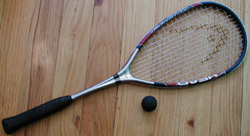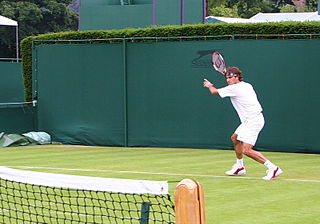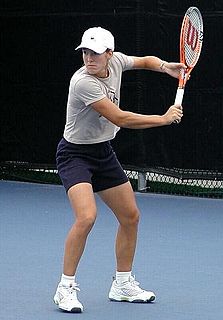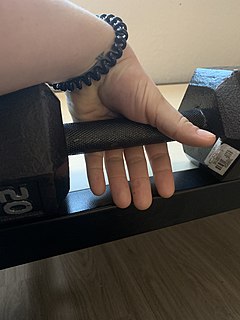
Badminton is a racquet sport played using racquets to hit a shuttlecock across a net. Although it may be played with larger teams, the most common forms of the game are "singles" and "doubles". Badminton is often played as a casual outdoor activity in a yard or on a beach; formal games are played on a rectangular indoor court. Points are scored by striking the shuttlecock with the racquet and landing it within the opposing side's half of the court.

Table tennis, also known as ping-pong and whiff-whaff, is a sport in which two or four players hit a lightweight ball, also known as the ping-pong ball, back and forth across a table using small rackets. The game takes place on a hard table divided by a net. Except for the initial serve, the rules are generally as follows: players must allow a ball played toward them to bounce one time on their side of the table and must return it so that it bounces on the opposite side at least once. A point is scored when a player fails to return the ball within the rules. Play is fast and demands quick reactions. Spinning the ball alters its trajectory and limits an opponent's options, giving the hitter a great advantage.

A racket or racquet is a sports implement consisting of a handled frame with an open hoop across which a network of strings or catgut is stretched tightly. It is used for striking a ball or shuttlecock in games such as squash, tennis, racquetball, rackets, badminton and padel. Collectively, these games are known as racket sports. Racket design and manufacturing has changed considerably over the centuries.

A scalpel, or lancet, or bistoury, is a small and extremely sharp bladed instrument used for surgery, anatomical dissection, podiatry and various arts and crafts. Scalpels may be single-use disposable or re-usable. Re-usable scalpels can have permanently attached blades that can be sharpened or, more commonly, removable single-use blades. Disposable scalpels usually have a plastic handle with an extensible blade and are used once, then the entire instrument is discarded. Scalpel blades are usually individually packed in sterile pouches but are also offered non-sterile. Double-edged scalpels are referred to as "lancets".

A guitar pick is a plectrum used for guitars. Picks are generally made of one uniform material—such as some kind of plastic, rubber, felt, tortoiseshell, wood, metal, glass, tagua, or stone. They are often shaped in an acute isosceles triangle with the two equal corners rounded and the third corner less rounded. They are used to strum chords or to sound individual notes on a guitar.

The sai is a traditional Okinawan melee weapon used for stabbing and blocking. It is used in ninjutsu and kobujutsu. The basic form of the weapon is that of a dull metal prong with two curved sideprongs (yoku) projecting from the handle (tsuka). There are many different types of sai with varying prongs for trapping and blocking.

Grip strength is the force applied by the hand to pull on or suspend from objects and is a specific part of hand strength. Optimum-sized objects permit the hand to wrap around a cylindrical shape with a diameter from one to three inches. Stair rails are an example of where shape and diameter are critical for proper grip in case of a fall. Other grip strengths that have been studied are the hammer and other hand tools. In applications of grip strength, the wrist must be in a neutral position to avoid developing cumulative trauma disorders (CTDs).
In tennis, a grip is a way of holding the racquet in order to hit shots during a match. The three most commonly used conventional grips are: the Continental, the Eastern and the Semi-Western. Most players change grips during a match depending on what shot they are hitting.

The forehand in tennis and other racket sports such as table tennis, squash and badminton is a shot made by swinging the racket across one's body with the hand moving palm-first. In tennis, except in the context of the phrase forehand volley, the term refers to a type of groundstroke—a stroke in which the ball has bounced before it is struck. It contrasts with the backhand, the other type of groundstroke. For a right-handed player, the forehand is a stroke that begins on the right side of the body, continues across the body as contact is made with the ball, and ends on the left side of the body. It is considered the easiest shot to master, perhaps because it is the most natural stroke. Beginners and advanced players often have better forehands than any other shots and use it as a weapon.

The backhand is a tennis shot in which one swings the racquet around one's body with the back of the hand preceding the palm. Except in the phrase backhand volley, the term refers to a groundstroke. It contrasts with the other kind of groundstroke, the forehand. The term is also used in other racquet sports, and other areas where a similar motion is employed.
In tennis, there are a variety of types of shots which can be categorized in various ways. The grip you place on will help you have different types of shots, the lower your grip means that the ball is most likely going to be a ground stroke. According to William T. Tilden, "All tennis strokes, should be made with the body' at right angles to the net, with the shoulders lined up parallel to the line of flight of the ball." The serve is the opening shot of a point. Groundstrokes are hit after the ball has already bounced, and can be either forehands or backhands depending on which direction the racket is swung relative to the body. A lob is a groundstroke hit well over the head of an opponent who is positioned at the net. A passing shot is a groundstroke that is hit out of reach of an opponent at the net far to his left or right. A cross-court shot is a shot hit from the left side of one player's court to the left side of the other player's court, so that it crosses the lengthwise centerline of the court. A down-the-line shot is one that is hit more or less parallel to, and near to, one of the sidelines, so that it never crosses the centerline.
This page is a glossary of tennis terminology.
Table tennis is unique among racket sports in that it supports a large variety of different styles of players. As players' levels increase, the diversity of styles decreases slightly, because technically weak styles are quickly eliminated; but, even at the very top of international table tennis, there are many dramatically different styles to be found. As of 2021, attacking styles dominate most of the top places in the world. However, this may be due to the relative popularity of attack over defense, as defensive players are still able to reach the highest levels of international competition.

In ball sports, topspin is a property of a ball that rotates forwards as it is moving. Topspin on a ball propelled through the air imparts a downward force that causes the ball to drop, due to its interaction with the air. Topspin is the opposite of backspin.

Hook grip is a method of gripping a barbell used in many strength-related sports such as Olympic weightlifting, Crossfit, and powerlifting by overlapping the index and middle finger over the thumb. This method of gripping the bar provides a secure bar grip while performing pulling motion with the barbell such as the clean and jerk, snatch, and deadlift. To perform a hook grip one must first wrap their thumb around the bar placing it parallel to the barbell and then wrap their index, and middle finger around the outside of the thumb. The pinky and ring finger typically ends up resting on the barbell. It is important to actively hooking on to the thumb with the index and middle finger while performing Hook grip compared to providing direct pressure on to the thumb.
A bow draw is the method used to draw a bow. Currently, the most common method in modern target archery is the Mediterranean draw, long the usual method in European archery. Other methods include the pinch draw and the Mongolian or "thumb" draw. In traditional archery practice outside of Western Europe the variations of the thumb draw are by far the most dominant draw types with the Mediterranean draw restricted to Olympic style of target shooting.

A hand is a prehensile, multi-fingered appendage located at the end of the forearm or forelimb of primates such as humans, chimpanzees, monkeys, and lemurs. A few other vertebrates such as the koala are often described as having "hands" instead of paws on their front limbs. The raccoon is usually described as having "hands" though opposable thumbs are lacking.
In robotics, an end effector is the device at the end of a robotic arm, designed to interact with the environment. The exact nature of this device depends on the application of the robot.
The Fulcrum grip is a four-mallet grip for vibraphone and marimba developed by vibraphonist and educator Ed Saindon. The aim of the grip is to use varying fulcrum positions and finger technique to achieve the control, speed, and power of a two-mallet grip while being able to use all four mallets.












